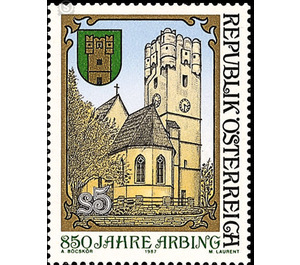850 years - Austria / II. Republic of Austria 1987 - 5 Shilling
Theme: Architecture
| Country | Austria / II. Republic of Austria |
| Issue Date | 1987 |
| Face Value | 5.00 |
| Color | multi-colored brown |
| Printing Type | combination printing |
| Stamp Type | Commemorative |
| Item Type | Stamp |
| Chronological Issue Number | 1238 |
| Chronological Chapter | OOS-OE2 |
| SID | 502360 |
| In 69 Wishlists | |
The municipality Arbing is located at the transition from the mountainous Mühlviertel into Machland and Danube basin. On Arbinger soil human habitation since the Neolithic period (about 5000 - 1900 BC) with certainty detectable. The place name is derived from the personal name Arbeo or Arbo and is therefore a real ing name, which indicates a foundation of the place in the early Middle Ages (8th or 9th century) by the tribe of Bavaria. From this time, however, a mention of the place name is missing. The first documentary mention falls in the year 1137. In a deed of the Austrian Duke Leopold IV. This waives all claims to the goods of the monastery of St. Florian am Windberg. Among the witnesses to this disclaimer is also called a "Gerboto de arbingin". The area of Arbing belonged in ecclesiastical matters to the already 823 mentioned parish of origin Naarn. The church (castle chapel) in the area of the medieval castle was the baptistery of the parish of Naarn. 1147 Arbing was incorporated into the newly founded Stift Waldhausen, which exercised the parishes in Arbing until the abolition of the pen under Leopold II (1790-1792). The village of Arbings is dominated today by preserved parts of the old castle building and the medieval church with its unique fortified tower.


